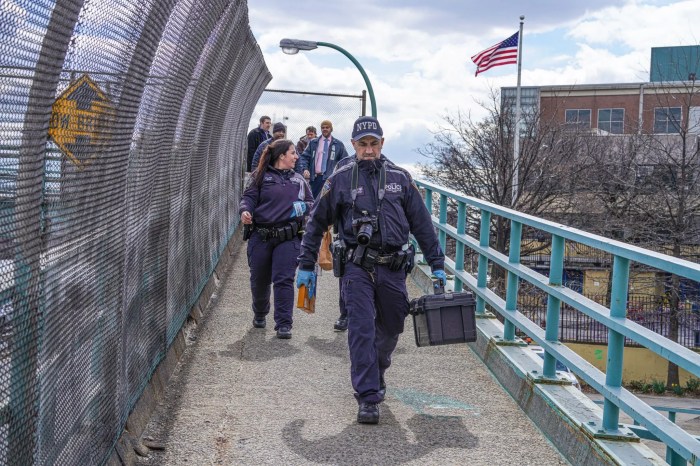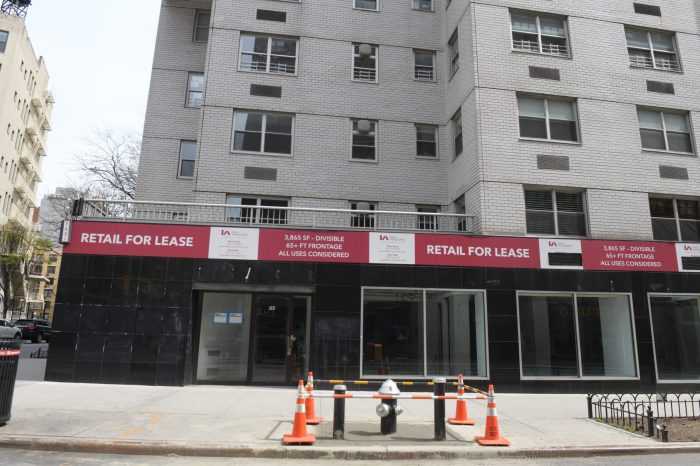
The west end of Peck Slip Plaza.
BY DUSICA SUE MALESEVIC | It has been almost 14 years since Sept. 11, eight years since Community Board 1 approved a design, nine months since it championed a “simplified” plan and now it’ll be another two years for the plaza area to be complete at Peck Slip, between South and Water Sts.
If construction begins on the half-acre Peck Slip Plaza next spring, then it will be finished spring 2017, said Lawrence Mauro, program manager for Lower Manhattan projects for the city’s Parks Dept.
“Now the Peck Slip school will open in September and then there’ll be another construction project right there for the kids,” said Catherine McVay Hughes, C.B. 1 chairperson.
Part of the delay, Mauro told the board’s Seaport Committee at their Tues., July 23 meeting, was that city approvals for the bidding process is taking about a year.
But the most recent delay was not the only news the community board cared about. Members want less, not more when it came to Peck Slip, with many saying it is fine in its current state. The design for the South Street Seaport Historic District that was approved in 2007 included more trees and decoration that were supposed to evoke ship’s ribs, but that many refer to as whalebones.
The Lower Manhattan Development Corporation, or L.M.D.C., which is funding the project to the tune of $4 million, met with Mauro about Peck Slip in January. The corporation, which operates now with a skeletal staff, was formed to manage Lower Manhattan’s recovery after Sept. 11 and is federally funded.
The city plans to proceed even if it means paying for elements the community board no longer wants.
“The decision coming out of that meeting was that the funding was truly in jeopardy if we did not move,” explained Mauro. “That we would bid the project, see how the bids came in and if the bids were over then we would discuss editing elements of the project out, but only then.”
This did not site well with some community board members.

Jason Friedman, a committee member and an architect, said that 2007 design had an “air of it not suiting the community.” He and other neighbors felt there was a need for more open space, and that cluttering the area up with modern elements did not fit the historic district.
Friedman had presented to the committee back in October when they had voted to approve a scaled back plan.
“This was heavily influenced by the funder — L.M.D.C.,” said Mauro.
David Emil, president of the L.M.D.C., said in a phone interview this week that he hopes a “modified version will meet everyone’s concerns.”
“L.M.D.C. is in its final phases and is anxious to proceed,” said Emil, who no longer collects a salary from the corporation.
Friedman said, “The biggest takeaway I think I remember was we kind of like [Peck Slip] just the way it is. The priorities of the community might be to lose money on the park and have them just not spend all the money they’ve allocated and just give it up ‘cause it’s a better solution.”
Hughes and Marco Pasanella, the committee’s chairperson, were also at the meeting with the L.M.D.C.
“I think everyone is conscious of what had gone on here and what the community’s wishes were,” said Pasanella.
Friedman said he was “shocked” that things were proceeding even though “we expressed a community a desire that we didn’t like that park.”
“The shock now is the delay and particularly when [13] and a half years after 9/11 to be still be spending L.M.D.C. money,” said Pasanella.
Paul Hovitz, another C.B. 1 member, asked Mauro what would happen if the city lost the funding for the project.
Peck Slip would remain as it is now, he said.
“Which is what exactly what we said we wanted,” said Hovitz.
Pasanella said editing the plan is still on the table.
Hughes concurred, saying, “For example, one feature that this community was vehement against was the whalebones in the park — an example of something that could be edited out.”

















